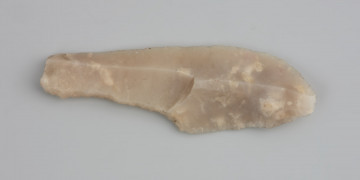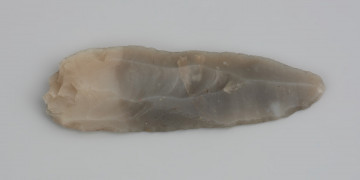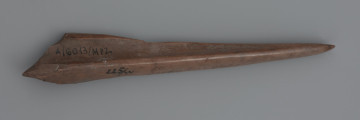
Single-jagged edge
11900 p.n.e. — 11000 p.n.e.
National Museum in Szczecin
Part of the collection: Stone Age
The cone-shaped core is part of a collection containing flints and fragments of pottery dated to different periods of the Mesolithic and Neolithic, gathered by R. Richter in June 1939 near Morzyczyn, the district of Stargard. It was made from a lump of very high-quality flint. It was used to reflect shavings, i.e., longitudinal fragments of flint, a semi-raw material for producing various tools using the pressure technique, which involved placing a bone or antler on the flint core and applying intense pressure, causing the shavings to fall off. The core heel, i.e., the surface to which the presser was applied, is flat, formed in one stroke. This type of handling is characteristic of makers from the Mesolithic period in the western Baltic zone. In the final exploitation phase, shortly before abandonment, one of the sides of the core was partially rebounded with a stone pestle. Traces of various treatments for minor repairs to the top and back of the core are also visible. The beginning of the Middle Mesolithic was associated with some quite significant technological changes. The introduction of new techniques, including pressing, greatly facilitated the production of chips. Mesolithic communities tended to manage the raw flint material quite sparingly. Large lumps were initially worked using an intermediary, i.e., a bone or antler fragment, applied to the core and stuck with a pestle. As the core became smaller, they gradually switched to producing chips using pressure. Keeping the cores small was facilitated by immobilising them in simple holders called immobilisers. The specimen from Morzyczyn is an example of a highly used core, abandoned when further exploitation was no longer possible. Interesting are the traces preserved on one side, which testify to adapting the size and shape of the core to the immobiliser during the pressing of chips. The pressure core from Morzyczyn should be associated with the Middle Maglemose culture (c. 7800-7000 BC).
Michał Adamczyk
Author / creator
Dimensions
cały obiekt: height: 3.8 cm, width: 2.1 cm
Object type
lithic core, production waste
Technique
carving, pressure carving, hard masher carving
Material
flint, stone
Origin / acquisition method
acquisition
Creation time / dating
Creation / finding place
Owner
National Museum in Szczecin
Identification number
Location / status

11900 p.n.e. — 11000 p.n.e.
National Museum in Szczecin

11900 p.n.e. — 11000 p.n.e.
National Museum in Szczecin

9600 p.n.e. — 4100 p.n.e.
National Museum in Szczecin
DISCOVER this TOPIC
Castle Museum in Łańcut
DISCOVER this PATH
Educational path